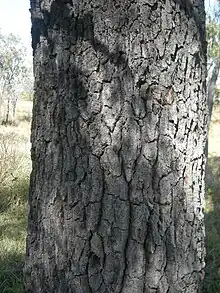| Beefwood | |
|---|---|
 | |
| Grevillea striata in coastal Central Queensland | |
| Scientific classification | |
| Kingdom: | Plantae |
| Clade: | Tracheophytes |
| Clade: | Angiosperms |
| Clade: | Eudicots |
| Order: | Proteales |
| Family: | Proteaceae |
| Genus: | Grevillea |
| Species: | G. striata |
| Binomial name | |
| Grevillea striata | |
 | |
| Occurrence data from AVH | |
| Synonyms[1] | |
|
List
| |


Grevillea striata, commonly known as beefwood or silver honeysuckle,[2] is a species of flowering plant in the family Proteaceae and is endemic to continental Australia. It is a shrub or tree with linear leaves and white to cream-colured or pale yellow flowers. Other common names for this species include western beefwood, beef oak and beef silky oak.[3]
Description
Grevillea striata is an erect, spindly shrub or robust tree with dark, fissured bark, that typically grows to a height of 3–15 m (9.8–49.2 ft), the trunk up to 60 cm (24 in) in diameter. Its leaves are linear or strap-like and often wavy, 100–450 mm (3.9–17.7 in) long and 2–15 mm (0.079–0.591 in) wide. The lower surface of the leaves has 5 to 13 prominent striations. The flowers are arranged in clusters with up to 12 branches, each branch cylindrical and 50–140 mm (2.0–5.5 in) long. The flowers are white to cream-colured or pale yellow, the pistil 6–10 mm (0.24–0.39 in) long. Flowering mainly occurs from August to December, and the fruit is an almost smooth, oblong to oval follicle 13–21 mm (0.51–0.83 in) long.[2][4][5][6][7]
Taxonomy and naming
Grevillea striata was first formally described in 1810 by botanist Robert Brown in the Transactions of the Linnean Society of London, from specimens collected near the coast of the Gulf of Carpentaria.[8][9] The specific epithet (striata) means "striate", referring to the veins on the lower surface of the leaves.[4][10]
This species is known as beefwood due to the intense red colour of its heartwood.[11]
Distribution and habitat
Beefwood grows in woodland, shrubland and spinifex communities in a range of soil types. It occurs in all mainland states except Victoria.[2][3][5][6][7][12]
Some specimens are long-lived. A tree still stands bearing an inscription in memory of James Poole, a member of Charles Sturt's expedition in 1845, although the tree must have been mature at the time of carving. Poole, having died of scurvy, was buried near a beefwood tree at Preservation Creek near Milparinka, and an inscription "JP 1845" was carved into the tree.[4][13][14]
Uses
Indigenous uses
Aboriginal people used resin from the tree to stick flints to their cutting tools. They also reportedly used charcoal from the tree to treat wounds and promote healing.[4][7]
Building material
Due to its durability and the fact that it splits readily, the timber was used by early settlers for fence posts, shingles and flooring.[11] The wood of this species is extremely dense, with a air-dry density of 965 kg/m3 (1,627 lb/cu yd) and a green density of 1,230 kg/m3 (2,070 lb/cu yd)[15]: 2
References
- 1 2 "Grevillea striata". Australian Plant Census. Retrieved 7 March 2023.
- 1 2 3 "Grevillea strita". Australian Biological Resources Study, Department of Agriculture, Water and the Environment: Canberra. Retrieved 7 March 2023.
- 1 2 "Grevillea striata". Queensland Government Department of Environment and Science. Retrieved 7 March 2023.
- 1 2 3 4 Wrigley, John W.; Fagg, Murray A. (1991). Banksias, waratahs & grevilleas : and all other plants in the Australian Proteaceae family. North Ryde, NSW, Australia: Angus & Robertson. pp. 336–337. ISBN 0207172773.
- 1 2 Makinson, Robert O. "Grevillea striata". Royal Botanic Garden Sydney. Retrieved 7 March 2023.
- 1 2 "Grevillea striata". Northern Territory Government. Retrieved 7 March 2023.
- 1 2 3 "Grevillea striata". State Herbarium of South Australia. Retrieved 7 March 2023.
- ↑ "Grevillea striata". APNI. Retrieved 7 March 2023.
- ↑ Brown, Robert (1810). "On the Proteaceae of Jussieu". Transactions of the Linnean Society of London. 10 (1): 177. Retrieved 7 March 2023.
- ↑ Sharr, Francis Aubi; George, Alex (2019). Western Australian Plant Names and Their Meanings (3rd ed.). Kardinya, WA: Four Gables Press. p. 315. ISBN 9780958034180.
- 1 2 Wiltshire, D.; Schmidt, M. (2003). Field guide to the common plants of the Cooper Basin (PDF). Santos. ISBN 1875568042.
- ↑ "Grevillea striata". FloraBase. Western Australian Government Department of Biodiversity, Conservation and Attractions.
- ↑ Moore P. (2005). Plants of Inland Australia. Reed New Holland. ISBN 187633486X.
- ↑ "James Poole". Monument Australia. Retrieved 7 March 2023.
- ↑ "Species Information" (PDF). Forest Products Commission. Government of Western Australia. Retrieved 8 January 2023.